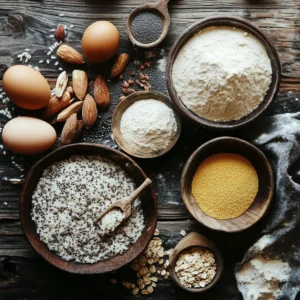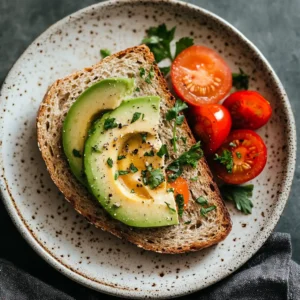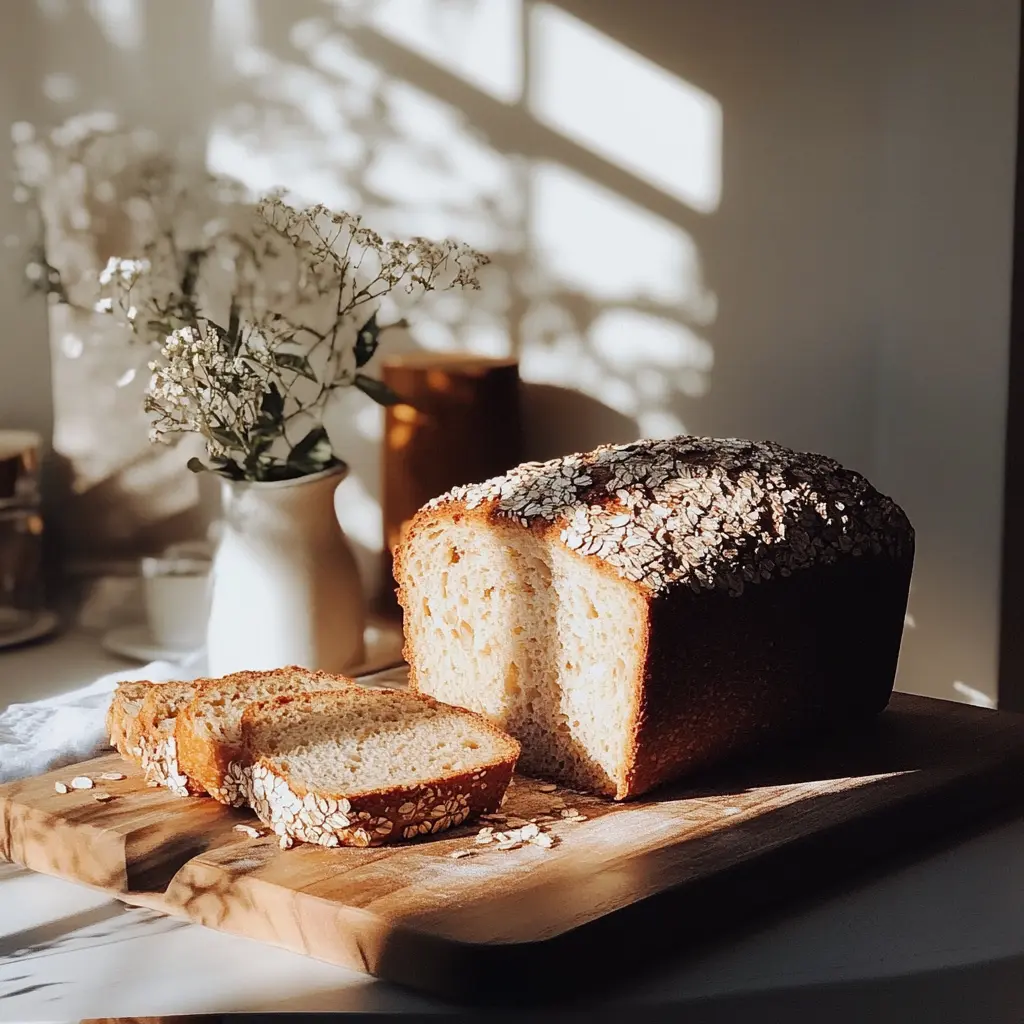Why High-Protein Gluten-Free Bread is a Perfect Choice
High-protein gluten-free bread is a game-changer for anyone seeking a nutritious alternative to traditional wheat-based loaves. Whether you’re avoiding gluten due to dietary restrictions or simply looking to add more protein to your meals, this bread delivers on taste, texture, and nutrition.
In recent years, gluten-free diets have surged in popularity, catering to individuals with celiac disease, gluten sensitivities, or those pursuing healthier eating habits. Bread, a staple in many diets, often becomes a challenge for those avoiding gluten, as traditional recipes rely heavily on wheat-based ingredients for structure.
On the other hand, protein-rich diets are recognized for their ability to support muscle growth, manage weight, and promote overall health. High-protein gluten-free bread bridges the gap between these two dietary trends, providing a satisfying solution for health-conscious eaters.

Gluten-free bread is a type of bread made without wheat, barley, rye, or any other gluten-containing grains. For individuals with celiac disease, an autoimmune disorder, consuming gluten can cause severe digestive issues and damage to the small intestine. Others may experience non-celiac gluten sensitivity, leading to discomfort or bloating when consuming gluten. As a result, gluten-free bread has become a vital option for those seeking alternatives to traditional wheat-based loaves.
Benefits of Gluten-Free Bread
- Healthier Option for Sensitive Individuals
Gluten-free bread provides a safe alternative for those with gluten intolerance or celiac disease, enabling them to enjoy a staple food without adverse effects. - Versatility
Gluten-free bread can be adapted to suit a variety of flavors, textures, and nutritional needs, offering a broader appeal even for those without dietary restrictions. - Allergy-Friendly
Many gluten-free recipes avoid common allergens, making them suitable for individuals with multiple dietary restrictions. - Promotes Digestive Health
Gluten-free bread often includes ingredients like rice flour, almond flour, or chia seeds, which are naturally easier to digest and may benefit gut health.
Common Ingredients in Gluten-Free Bread
- Gluten-Free Flours
Gluten-free bread relies on alternative flours such as rice flour, almond flour, coconut flour, or sorghum flour. These ingredients are essential to replace the structural role gluten plays in traditional bread. - Binders
Without gluten, binders like xanthan gum or psyllium husk are added to provide elasticity and hold the bread together. - Leavening Agents
Ingredients like baking powder, yeast, or baking soda help the bread rise and achieve a light texture. - Flavor Enhancers
To improve taste, gluten-free bread often incorporates ingredients like honey, herbs, or spices.
Gluten-free bread may lack the traditional structure provided by gluten, but with the right ingredients and techniques, it is possible to create a loaf that is every bit as satisfying as its wheat-based counterpart. In the next section, we will dive into the role of protein and how it contributes to the success of gluten-free baking.
The Role of Protein in Bread
Protein is a fundamental component in bread making, especially in gluten-free recipes. In traditional bread, gluten—composed of glutenin and gliadin proteins—provides the dough with elasticity, strength, and structure. Without gluten, bakers must look for alternative proteins to replicate these qualities and ensure the bread is both nutritious and structurally sound.
Why Protein is Important in Bread
- Improves Texture
Protein helps mimic the chewy, elastic texture associated with traditional bread. In gluten-free baking, it compensates for the lack of gluten’s stretchiness. - Enhances Structure
Protein strengthens the bread’s structure, preventing it from crumbling or becoming too dense. - Boosts Nutrition
High-protein ingredients like eggs, dairy products, or protein powders enhance the bread’s nutritional profile, making it suitable for muscle repair, energy, and satiety. - Extends Freshness
Protein-rich bread tends to retain moisture better, improving shelf life and reducing the risk of it becoming dry or stale.
Challenges in Gluten-Free Baking
Creating high-protein gluten-free bread comes with its own set of challenges:
- Structural Weakness
Without gluten, gluten-free bread often lacks the elasticity and springiness of traditional dough, leading to a crumbly texture. - Difficulty in Rising
Gluten helps trap air, which is crucial for rising. Replicating this process with alternative proteins requires careful ingredient selection. - Flavor Balance
High-protein ingredients can sometimes have strong flavors (e.g., pea protein), which need to be balanced to achieve a pleasant taste.
Common Protein Sources for Gluten-Free Bread
- Eggs
Eggs are a natural protein powerhouse that also act as a binder, enhancing both structure and moisture in gluten-free bread. - Dairy Proteins
Ingredients like Greek yogurt, whey protein powder, or milk provide richness and softness while increasing protein content. - Plant-Based Proteins
For vegans or those avoiding dairy, plant-based options like pea protein, hemp protein, or soy protein are excellent alternatives. - Seeds and Nuts
Chia seeds, flaxseeds, and almond flour contribute protein while also adding texture and flavor. - Legume Flours
Chickpea flour and lentil flour offer high protein and a subtle, earthy taste that complements bread recipes.
By carefully selecting high-protein ingredients and addressing the challenges of gluten-free baking, it’s possible to craft bread that is not only satisfying and delicious but also packed with nutritional benefits. In the next section, we will explore a detailed recipe to help you make your own high-protein gluten-free bread at home.
Recipe for High Protein Gluten-Free Bread
Creating your own high-protein gluten-free bread at home is both rewarding and practical. This recipe combines nutritious ingredients to deliver a delicious loaf that is perfect for sandwiches, toast, or simply enjoying on its own.
Ingredients
Dry Ingredients:
- 1 ½ cups almond flour (high in protein and gluten-free)
- 1 cup gluten-free oat flour
- ¼ cup whey protein powder (or plant-based protein powder for a vegan option)
- 2 tbsp psyllium husk powder (for binding and texture)
- 1 tbsp baking powder
- ½ tsp baking soda
- ½ tsp salt
Wet Ingredients:
- 3 large eggs (or flaxseed eggs for a vegan option: 1 tbsp flaxseed meal + 2.5 tbsp water per egg)
- 1 cup unsweetened almond milk (or any preferred non-dairy milk)
- 2 tbsp olive oil
- 1 tbsp honey (or maple syrup for a vegan option)
- 1 tsp apple cider vinegar
Optional Add-Ins:
- 2 tbsp chia seeds or flaxseeds for added crunch and nutrition.
- ¼ cup sunflower seeds or pumpkin seeds for texture and flavor.
Heading 3: Instructions
- Preheat the Oven
Preheat your oven to 350°F (175°C) and line a 9×5-inch loaf pan with parchment paper. - Prepare the Dry Ingredients
In a large mixing bowl, combine almond flour, oat flour, protein powder, psyllium husk powder, baking powder, baking soda, and salt. Whisk these together to ensure even distribution. - Mix the Wet Ingredients
In another bowl, whisk together eggs, almond milk, olive oil, honey, and apple cider vinegar until smooth. - Combine Wet and Dry Ingredients
Gradually pour the wet ingredients into the dry mixture. Stir until well incorporated. The batter should be thick but pourable. If it feels too dry, add a splash more almond milk. - Add Optional Ingredients
Fold in any optional add-ins, such as seeds or nuts, to enhance the flavor and texture of the bread. - Pour into the Pan
Pour the batter into the prepared loaf pan and smooth the top with a spatula. - Bake
Place the pan in the oven and bake for 40-50 minutes, or until a toothpick inserted into the center comes out clean. - Cool
Allow the bread to cool in the pan for 10 minutes before transferring it to a wire rack to cool completely.
Heading 3: Baking Tips for Success
- Don’t Overmix
Overmixing can make gluten-free bread dense. Stir just until the ingredients are combined. - Monitor the Moisture
Gluten-free breads tend to dry out quickly. Keep an eye on the consistency of the batter and the baking time. - Use Fresh Ingredients
Baking powder, baking soda, and psyllium husk powder lose their effectiveness over time. Always use fresh ingredients for the best results.
This easy-to-follow recipe delivers a soft, flavorful, and protein-rich bread perfect for gluten-free diets. The next section will focus on the nutritional benefits of this bread, including how it compares to regular bread.

High-protein gluten-free bread offers several health advantages, making it a great addition to a balanced diet. Whether you’re an athlete seeking muscle recovery, someone with dietary restrictions, or simply looking for healthier bread options, this loaf ticks all the boxes.
Macronutrient Breakdown
1. Protein Content
- This bread contains around 8-12 grams of protein per slice, depending on the ingredients used (e.g., whey protein or plant-based powders).
- Protein supports muscle repair, enhances satiety, and helps regulate blood sugar levels.
2. Lower in Carbohydrates
- Gluten-free flours like almond and oat flour have a lower carbohydrate content than traditional wheat flour.
- Ideal for low-carb or ketogenic diets.
3. Healthy Fats
- Ingredients like almond flour and olive oil add monounsaturated fats, which are heart-healthy and anti-inflammatory.
4. Fiber-Rich
- Psyllium husk, chia seeds, and flaxseeds contribute significant fiber, promoting digestive health and keeping you full longer.
5. Reduced Sugar
- Sweeteners like honey or maple syrup are used sparingly, ensuring the bread is naturally sweet without being high in added sugars.
Suitable for Various Diets
1. Gluten-Free Diets
- Made without wheat, barley, or rye, this bread is safe for individuals with celiac disease or gluten sensitivity.
2. High-Protein Diets
- With its protein-packed ingredients, this bread complements fitness-focused and weight-management plans.
3. Vegan Diets (with Substitutions)
- Replacing eggs with flaxseed eggs and using plant-based protein powder makes this bread entirely plant-based.
4. Low-Carb Diets
- The low carbohydrate content and high protein profile make it suitable for those on ketogenic or low-carb diets.
How It Compares to Regular Bread
| Aspect | High Protein Gluten-Free Bread | Traditional Wheat Bread |
|---|---|---|
| Protein Content | Higher (8-12g per slice) | Lower (3-5g per slice) |
| Gluten-Free | Yes | No |
| Fiber | Higher, due to added seeds and psyllium husk | Moderate |
| Carbohydrates | Lower (depends on flour type) | Higher |
| Shelf Life | Moist and fresh for longer with proper storage | Tends to stale faster without preservatives |
Additional Health Benefits
- Stabilized Blood Sugar Levels
The combination of protein, fiber, and healthy fats slows down carbohydrate absorption, reducing blood sugar spikes. - Improved Satiety
High protein and fiber content keep you fuller longer, reducing unnecessary snacking. - Gut Health
Fiber from psyllium husk and seeds supports healthy digestion and feeds beneficial gut bacteria. - Energy Boost
With a balance of macronutrients, this bread provides sustained energy without the crash associated with refined carbs.
By replacing traditional wheat-based bread with high-protein gluten-free bread, you can enjoy the taste and texture of bread while meeting specific dietary and nutritional goals. In the next section, we’ll discuss some tips and tricks to ensure your gluten-free baking experience is as smooth and successful as possible.
Baking gluten-free bread, especially one high in protein, can be a rewarding challenge. The lack of gluten means the process differs from traditional bread baking. Here are some essential tips and tricks to ensure success every time.
Handling Gluten-Free Dough
- Expect a Different Texture
- Gluten-free dough is often stickier and less elastic than traditional dough. This is normal, so resist the urge to add more flour.
- Use a Mixer or Spoon
- Avoid kneading by hand; instead, use a stand mixer or spoon to mix the dough until it reaches the correct consistency.
- Let it Rest
- Allow the batter to sit for 5-10 minutes before baking. This helps ingredients like psyllium husk and flaxseeds absorb moisture and thicken.
Substitutions for Customization
- Protein Powder Substitutes
- If you don’t have whey or plant-based protein powder, you can use collagen peptides or egg white powder for a protein boost.
- Flour Swaps
- Replace almond flour with sunflower seed flour for a nut-free version. Use sorghum or teff flour for a heartier loaf.
- Egg Alternatives
- For an egg-free option, flaxseed or chia seed eggs work well. These also add fiber and omega-3s.
- Sweeteners
- Replace honey or maple syrup with stevia or monk fruit sweetener for a sugar-free version.
Tricks for Better Results
- Preheat the Oven
- Start with a fully preheated oven to ensure even baking and proper rise.
- Use the Right Pan
- A non-stick or parchment-lined loaf pan prevents sticking and makes removing the bread easier.
- Add Moisture
- Place a small dish of water in the oven while baking to create steam, which helps prevent the bread from drying out.
- Check for Doneness
- Insert a toothpick into the center of the loaf; it should come out clean when the bread is fully baked.
- Cool Completely
- Let the bread cool on a wire rack before slicing to avoid a gummy texture.
Storage and Shelf Life
- Refrigeration
- Store in an airtight container in the refrigerator for up to 5-7 days to maintain freshness.
- Freezing
- Slice the bread before freezing and store slices in a freezer-safe bag for up to 3 months. Simply thaw slices as needed.
- Reheating
- For the best texture, reheat slices in a toaster or oven instead of microwaving.
Variations to Try
- Seeded Loaf
- Add sesame seeds, poppy seeds, or pumpkin seeds for extra crunch and flavor.
- Savory Herb Bread
- Incorporate fresh rosemary, thyme, or garlic for a savory twist.
- Sweet Version
- Mix in dried fruit like raisins or cranberries and a dash of cinnamon for a slightly sweet loaf.
Gluten-free baking is a creative process, and each adjustment brings new possibilities. With practice and these tips, you’ll master the art of crafting delicious, high-protein gluten-free bread that caters to your taste and dietary needs.
Conclusion
High-protein gluten-free bread offers the best of both worlds: it meets dietary restrictions while delivering enhanced nutrition. With its unique blend of gluten-free flours, protein-packed ingredients, and thoughtful preparation, this bread is a versatile addition to any meal plan. Whether you’re avoiding gluten for medical reasons or simply aiming for a healthier lifestyle, this recipe provides a satisfying, delicious option.
Now it’s your turn to experiment with flavors, textures, and nutritional add-ins to make this bread your own. With a little practice, you’ll create loaves that are not just gluten-free but truly extraordinary.


